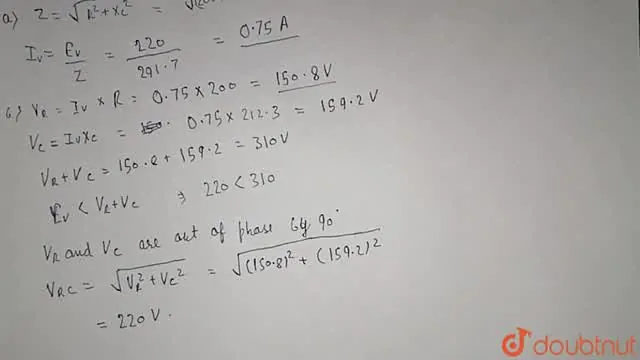A resistor of 200Ωand a capacitor of 15.0μF are connected in series to a 220V,50Hz source.
(a) Calculate the current in the circuit .
(b) Calcutalte the voltage (rms) across the resistor and the inductor. Is the algebraic sum of these voltages more than the source voltage? If yes, resolve the paradox.
Given
R=200Ω,C=15.0μF=15.0×10−6F
V=220V,v=50Hz
(a) In order to calculate the current, we need the impedance of the circuit. It is
Z=√R2+x2C=√R2+(2πvC)−2
=√(200Ω)2+(2×3.14×50×15.0×10−6F)−2
−√(200Ω)2+(212.3Ω)2
=291.67 Ω
Therefore, the current in the circuit is
l=vz=220V291.5Ω=0.755A
(b) Since the current is the same throughout the circuit, we have
vR=1R=(0.755A)(200Ω)=151V
vc=1xc=(0.755A)(212.3Ω)=160.3V
The algebrate sum of the two voltages, VR and Vc is 311.3V which is more than the source voltage of 220 V. How to resolve this paradox? As you have learnt in the text, the two voltages are not in the same phase. Therefore, they cannot be added like ordinary numbers. The two voltages are out of phase by ninety degrees. Therefore, the total of these voltages must be obtained using the Pythagorean theorem:
VR+C=√V2R+V2C
Thus, if the phase difference between two voltages is properly taken into account, the total voltage across the resistor and the capacitor is equal to the voltage of the source.
Related Playlists
Similar Questions
A 0.2kΩ resistor and 15μF capacitor are connected in series to a 220 V, 50 Hz ac source. The impadance of the circuit is
View SolutionA 0.21 H inductor and a 12Ω resistance are connected in series to a 220 V, 50 Hz ac source.
The current in the circuit isView SolutionA 0.21H inductor and a 12ohm resistance are connected in series to a 220V. 50Hz ac source. Calculate the current in the circuit and the phase angle between the current and the source voltage.
View SolutionA 400 Ω resistor, a 3 H inductor and a 5 μF capacitor are connected in series to a 220 V, 50 Hz ac source. Calculate the :
(1) Impedance of the ciruit.
(ii) Current flowing through the circuit.View SolutionA 9/100(π) inductor and a 12Ω resistanace are connected in series to a 225 V, 50 Hz ac source. Calculate the current in the circuit and the phase angle between the current and the source voltage.
View SolutionA 0.21 H inductor and a 12Ω resistance are connected in series to a 220 V, 50 Hz ac source.
the phase angle between the current and the source voltage isView SolutionIf a capacitor of 8μF is connected to a 220 V, 100 Hz ac source and the current passing through it is 65 mA, then the rms voltage across it is
View SolutionA 200Ω resistor is connected to a 220 V, 50 Hz AC supply. Calculate rms value of current in the circuit. Also find phase difference between voltage and the current.
View SolutionA 0.21-H inductor and a 88−Ω resistor are connected in series to a 220-V, 50-Hz AC source. The current in the circuit and the phase angle between the current and the source voltage are respectively. (Useπ=22/7)
View SolutionA resistor and a capacitor are connected in series with an a.c. source. If the potential drop across the capacitor is 5 V and that across resistor is 12 V, applied voltage is
View Solution


